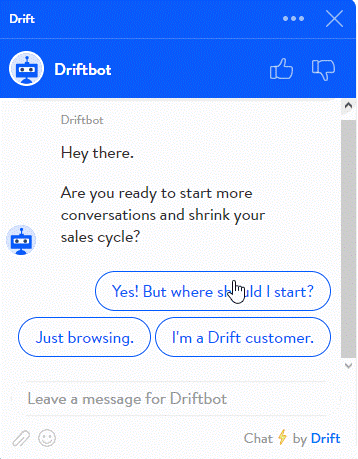By 2025, 80% of all sales will be done through a digital channel – the clearest signal yet that buying behaviors have permanently changed.
That means from buyer enablement to revenue acceleration, in this digital age, sales needs to do more than sell.
Why? Because today’s buyers rarely lack information. So it’s on sales to affirm buyers’ decisions and guide them towards their desired outcomes in meaningful, helpful ways.
Having a Conversational Sales strategy can help with that.
This framework gives your sales team a healthy pipeline of qualified opportunities and the real-time visibility, insights, and communication channels they need to prioritize target accounts, be more productive and win more business, faster.
Let’s get selling 💰
What Is Conversational Sales?
Conversational Sales is a forward-thinking model that knocks down the barriers between your sales team and potential customers. Instead of asking them to fill out lead forms, Conversational Sales gives your team a chance to talk to buyers in real-time, answer their questions and interact with them on their terms – not yours.
Sales has come a long way. But there’s still work to be done. Your buyers demand it.
The 2021 State of Conversational Sales report found that:
- 47% of sellers report their buyers are frustrated most by a lack of relevant or personalized website experiences, content, resources, or information to support their needs
- 42% of sellers report their buyers are frustrated most when they have to repeat the same information to multiple team members
- And 41% of sellers report their buyers are frustrated most when they’re asked to schedule a meeting before they’re ready to have one
As you can see, a lot of frustrations felt by today’s buyers now revolve around how a brand communicates with them. How personal your services are, how quickly a visitor can get information, and making them fill out repetitive forms can all have a negative impact on how they feel about your brand.
And that’s really where the key benefits of Conversational Sales come into play.
Why Is Conversational Sales Important?
With the help of AI chatbots, Conversational Sales ditches forms from the buying process and replaces them with an AI-powered chatbot.
But it does more than that. Conversational Sales empowers buyers to have conversations on their terms – not just when you reply to their inquiry or send out an automated email.
In fact, in the 2021 State of Conversational Sales report, 9 in 10 B2B sellers said they believe it is valuable to some degree to have a Conversational Sales solution in their sales process.
Why? When using a Conversational Sales solution:
- 53% of sellers saw improvements in overall revenue growth
- 49% saw improvements in their overall customer lifetime value
- 45% were able to learn more about their buyers in less time
- 42% were able to accelerate revenue generation
- 38% could book more qualified meetings

These numbers show that when you use Conversational Sales throughout the sales process, sales teams can optimize and engage at every stage of the customer lifecycle – offering each individual buyer a unique experience, catered to their needs, contexts, and histories.
Talk about a game-changer. So, how can you put Conversational Sales into action on your own site?
3 Steps to Put Conversational Sales into Action
Deploying a Conversational Sales approach within your team is easy – as long as you have a plan in place.
The first step is changing the way you think about a sale: it’s not about your company selling a product, it’s about the buyer and their goals. As soon as your team recognizes that, it gives them the freedom to follow a sales journey that fits the buyer – not a restrictive SDR playbook.
Then, it’s time to build out a framework you can use to engage buyers wherever they are in their journey using their channel of choice – email, phone, SMS, video, or chat. Breaking each piece of the sales journey down gives us a unique insight into every potential buyer. It tells us how engaged they are, what they did on our website, and why they came to us in the first place.
We call this strategy the Conversational Framework, and there are only three steps you need to remember to nail it:
🤝 Engage
💬 Understand
👍 Recommend

Let’s take a look at how they work.
Stage 1: Engage 👋
Every sale online starts in a similar way – a potential buyer has a problem, and they want to solve it.
So, they head to the nearest search engine and start researching.
I’ll give you an example.
Let’s say your buyer’s name is Christina and she’s the Head of Finance at a start-up.
Christina is looking for a better way to handle her company’s invoicing and billing, as the current tool isn’t a good fit for their business model. So, she googles “best invoicing platform for a start-up” and lands on your website.
At that moment, your AI-powered chatbot is triggered and pops up on her screen to help.
Here’s where the engagement part of the Conversational Sales framework gets interesting.
While Christina might think the assistant is having a casual conversation, what it’s actually doing is asking qualifying questions to see if she is a good fit for the product, while keeping the tone of the chat authentic and proactive.
Here’s an example of what those qualifying conversations look like over at Drift:

In Christina’s case, an automated workflow is used to engage her and learn about her problems and buying intent before she’s passed onto a real-life human. This is where the sales rep will take over organizing a demo and discuss how the features can benefit her start-up.
One important thing you should learn from your first interactions with buyers is that you need to engage with them on their terms. Authenticity and listening to what they need can go a long way in building trust early in the sales process.
That covers how Conversational Sales helps you engage buyers and get them into your pipeline.
How else can the framework help with closing deals?
Stage 2: Understand 💬
If I could give one piece of advice to everyone considering using the Conversational Sales framework, it would be this: sales is a two-way conversation.
Even with qualifying help, SDRs need to empathize with their buyer’s challenges, problems and focus on the most important part of any sale: the buyer’s goal.
That’s why forms are clunky.
They add friction to the entire sales process and don’t give buyers the immediate attention they desire. A smart AI-powered chatbot helps you deliver the level of attention buyers expect at all times, not just when your sales team is online.
The biggest win with this strategy is that you get a deep understanding of a visitor’s problems and what they need help with at that moment. And filling your gaps and automating the sales process’s initial engagement can save your team a ton of time filtering out qualified buyers.
When a chatbot hands over a potential buyer to your sales team, all your sales team has to do is steer the conversation, continue building on that trust by educating the buyer, and ultimately influencing them to make a purchasing decision.
This brings us to the last stage of the Conversational Framework: Recommend.
Stage 3: Recommend 👍
When we think about the sales journey, it’s easy to focus on outcomes like booking a demo or meeting.
But what if we flipped our thought process and instead of just pushing for outcomes like sales, we also used these conversations with potential buyers to build trust?
One of the best ways to do that is to show that you truly care about a buyer’s goal – not just pitching your product. And that’s what this part of the Conversational Sales framework revolves around: recommendations and information that will genuinely help your buyer.
If a buyer has complex questions about integrations or how your tool is used in their industry, an AI chatbot can give them the low down:

And is there something else you notice with this conversation?
The assistant isn’t trying to book a call or push a sale – it’s just trying to help and answer the buyer’s questions.
Each time the buyer interacts with your website is a chance to interact and make similar recommendations. It’s a pragmatic way to build trust, move the conversation forward, and hopefully get them to a place where they want to get on the phone with a sales rep.
Is Your Team Ready for a Conversational Sales Strategy?
The sales landscape has changed a lot. That’s obvious.
What’s not obvious is what companies need to do to keep up with their customer’s online expectations of response times, building trust, and engaging in a human way.
Conversational Sales brings the buying experience back to where it began: a customer and a business talking about a problem and how it can be solved.
Instead of filling out forms and waiting hours for a response, potential customers can now chat with a company in real-time and figure out whether or not their product can help. It adds a personable element to online sales and transforms it from a detached experience into one where customers take control over their buying journey.
A Conversational Sales strategy (and the right tools 🤖) brings a fresh approach to your website visitors. It gives them a better experience. They get their questions answered quickly. It empowers them to make better buying decisions. And it frees up your sales team to focus on truly qualified, interested buyers.
It’s time to ask yourself – is your team ready for Conversational Sales?









